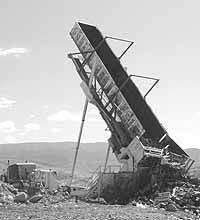| This truck loaded with construction debris is dumped by a hydraulic lift in a cell set aside for these kinds of materials. |
When people think of a landfill they generally only think about trash being dumped in a big hole and then it is covered over with dirt.
While that is basically what happens, the truth is that the whole process is much more complicated than that. The waste disposal industry is one of the most highly regulated industries in the country with not only federal regulations applying, but state and local regulations as well. ECDC falls under all these statutes.
The materials put in the landfill come from many places around the country, but every car that comes in is documented. If that paperwork does not accompany the load, it is rejected by ECDC officials.
The information on those records documents the source of the materials on the car and the kinds of materials contained. Once again if ECDC personnel find something different they can reject the load.
The loads are also scanned for any kinds of materials that might be hidden within them that don’t fit the landfills non-hazardous permit. One of the fears many residents of the area originally had was that hazardous type materials would be placed in the landfill, but a screening system, both visual and electronic is used on the loads.
One of the most obvious are three radiation screening towers that sit near the tracks on the north side of the complex and near the scales at the administration office. These can be seen from State Highway 123. This system screens all cars containers for radiation. If an alarm is set off hand held units are used to locate the exact source of radiation. Once the radiation source is located the state Division of Radiation is contacted to determine proper management and disposal of the material. In fact, natural occurring radioactive material (NORM) items have been detected such as uranium ore, and other debris commonly used in radiation treatment for cancer patients.
Once the loads are screened they are then stationed for container removal or dumping. In general there are three ways that materials come into the landfill.
The first is in open gondola train cars. That kind of waste is usually industrial waste, dirty dirt, etc. Those cars are dumped in the large building in the middle of the complex that can be seen from the highway. A diesel locomotive the landfill owns pulls the cars through the building and one by one they are rotated by a big machine and dumped into a bay where loaders load it into large trucks who transport it to the active cell (the prepared area where refuse is currently being deposited). While the cars are still tipped, large water cannons are used to wash the cars out.
| Radiation detectors border the track at ECDC to check cars for materials that may have levels over permitted allowances. |
The second way materials are shipped into the landfill is also by train car, but in containers that are familiar to any Carbon County resident. They are transported daily through the area. These containers come in various sizes and are owned by ECDC. Once those are screened and the paperwork is found in order, they are lifted off the flat cars, and transported by trucks to the active cell where they are turned over by a portable dumper and the material is placed and compacted in the active cell.
The final way materials are brought in is by truck. Most of the trucks that transport refuse to ECDC are from the local area. For instance City Sanitation that picks up the household garbage throughout the county brings their trucks to the landfill. The Carbon County Landfill also has it’s large containers of household garbage dumped by county residents brought to there as well. That includes the compacted garbage from the new compactor.
At present there is only one very active cell at ECDC. But in the past there have been a couple, including industrial material cells such as the cell used for the cleanup of General Motors plants all over the country on the south end of the complex.
Each level of material is covered over with dirt and then when a cell is completed a detailed closured design will be implemented once the waste reaches final grade. A gas collection and control system is also part of the cell closure.
Most importantly, though, each cell site is documented with paperwork so that officials can determine what has been placed in a cell site at any time. That is one of the reasons for large industrial waste cells that are separate from MSW (household waste) cells.
Waste stream flow is documented throughout its existence in this modern day and age. Companies that generate waste material have a “cradle to grave” responsibility for what they make. This means they must document not only the viable material they make, but also its by products.
In the MSW world, municipalities and others must document their waste stream flow too.
It is ECDC’s responsibility, as the final caretaker of these wastes to properly store and document materials until they break down in the environment.

